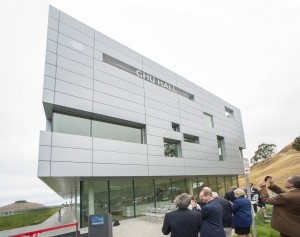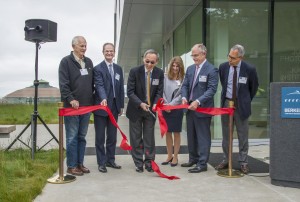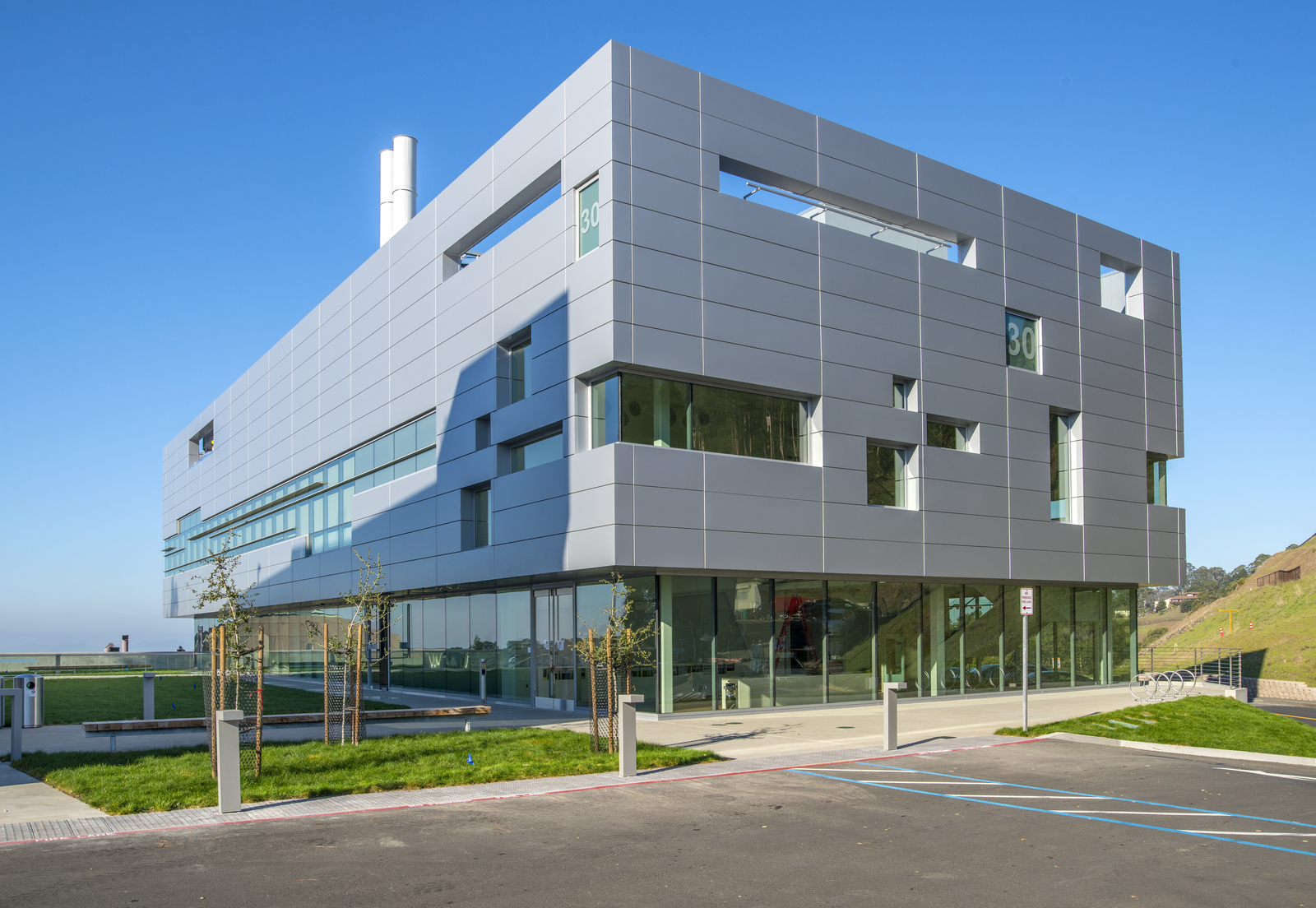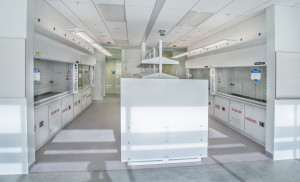Berkeley, CA, May 26, 2015—Mother Nature makes it happen so effortlessly and efficiently—turning sunlight, water and carbon dioxide into the building blocks for fuel for plants, that is. Now, researchers have a new home to replicate Mother Nature’s mysteries. The Solar Energy Research Center (SERC) opened today at the U.S. Department of Energy’s Lawrence Berkeley National Laboratory (Berkeley Lab) and will house laboratories and offices devoted to photovoltaic and electro-chemical solar energy systems designed to improve on what plants do and make transportation fuels. The building houses the lab’s programs in the Joint Center for Artificial Photosynthesis (JCAP), a Department of Energy hub led by the California Institute of Technology, with Berkeley Lab as a major partner.
 “We believe the opening of this building will provide a significant boost to solar fuels research,” says Berkeley Lab Director Paul Alivisatos. “It puts our researchers, from various disciplines, together in a single space, close to UC Berkeley and Berkeley Lab colleagues studying similar challenges.” Previously, JCAP researchers were in a leased space in West Berkeley.
“We believe the opening of this building will provide a significant boost to solar fuels research,” says Berkeley Lab Director Paul Alivisatos. “It puts our researchers, from various disciplines, together in a single space, close to UC Berkeley and Berkeley Lab colleagues studying similar challenges.” Previously, JCAP researchers were in a leased space in West Berkeley.
The three-story, nearly 40,000 square-foot, building cost $59 million with funding coming from the University of California, the California Public Utilities Commission, appropriations from the State of California, and private support from the Simons Foundation, Sea Change Foundation, and Mark Heising and Liz Simons. JCAP—which also includes as partners SLAC National Accelerator Laboratory and the University of California campuses at Irvine and San Diego—receives important funding from the California Energy Commission in addition to funding from DOE’s Office of Science.
“JCAP’s current mission is to demonstrate a scalable, sustainable device that can generate fuels from sunlight and air at least 10 times more efficiently than plants,” says Berkeley Lab’s JCAP head, Frances Houle.
Just last month, JCAP was renewed for another five years supported by $75 million in funding from DOE.

Cutting the ribbon to Chu Hall, left to right: Berkeley Mayor Tom Bates, Berkeley Lab Director Paul Alivisatos, Steven Chu, Laura Baxter-Simons and Mark Heising, and UC Berkeley Provost Claude Steele.
“In the renewal,” adds Houle, “we will build on progress made since 2010 to fulfill our mission to address the key challenge of replicating what plants can do: generate complex hydrocarbons from air and sunlight under mild conditions.”
The design of the building supports the lab’s team culture while providing space tailored to the specific work of JCAP researchers. Specialized spaces include low vibration rooms, large, reconfigurable lab spaces that can be easily adapted as the science evolves, and dedicated synthetic spaces with ample fume hoods.
The new building will house approximately 100 researchers in the JCAP project and will also be the lab’s home for the Kavli Energy NanoSciences Institute (Kavli ENSI), a program engaging researchers from Berkeley Lab and a number of UC Berkeley departments.
Kavli ENSI explores fundamental issues in energy science, using tools and techniques developed to study and manipulate nanomaterials. Its administrative offices will be housed in the new building.
The opening ceremony also marked another occasion, the official naming of the building to Chu Hall, after former Berkeley Lab Director Steven Chu, who later went on to become U.S. Energy Secretary.
“Steve’s commitment to ground-breaking science is really one of the reasons we’re naming this building after him,” adds Alivisatos. “We felt that his service to our lab, and to the country as Energy Secretary, could best be acknowledged by today’s naming.”
The new Chu Hall is aiming for LEED Gold Certification. It was designed by the SmithGroup of San Francisco and constructed by McCarthy Building Companies, Inc., also of San Francisco.
# # #
Lawrence Berkeley National Laboratory addresses the world’s most urgent scientific challenges by advancing sustainable energy, protecting human health, creating new materials, and revealing the origin and fate of the universe. Founded in 1931, Berkeley Lab’s scientific expertise has been recognized with 13 Nobel prizes. The University of California manages Berkeley Lab for the U.S. Department of Energy’s Office of Science. For more, visit http://www.lbl.gov
DOE’s Office of Science is the single largest supporter of basic research in the physical sciences in the United States, and is working to address some of the most pressing challenges of our time. For more information, please visit science.energy.gov.
JCAP, which has a northern branch in Berkeley and a southern branch on the campus of the California Institute of Technology (Caltech), was established in 2010 by the U.S. Department of Energy (DOE) as an Energy Innovation Hub. Operated as a partnership between Caltech and Berkeley Lab, JCAP is the largest research program in the United States dedicated to developing an artificial solar-fuel technology. It is funded through the DOE Office of Science.
The Kavli Energy NanoSciences Institute brings together world-class scientists in a variety of disciplines from Berkeley Lab and UC Berkeley to research how energy flows and can be controlled on the nanoscale. The program was established in 2013 with gifts from the Kavli Foundation, the Philomathia Foundation, and the Heising-Simons Foundation.

